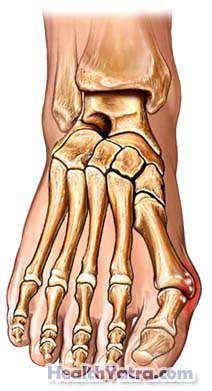Definition
A bunion removal is a surgery to repair a deformity in the joint that connects the big toe to the foot. It is done by removing excess bone in the joint area.

Reasons for Procedure
A bunion is an inflammation and enlargement of the big toe joint and the tissue around it. In some cases, the deformity is so severe that the big toe begins to slant toward the outside of the foot. Surgery to correct it is considered when:
- Other attempts at therapy have failed, such as anti-inflammatory drugs, physical therapy, specially shaped shoes, or inserts to decrease pressure
- The pain of a bunion interferes with walking
- The foot deformity makes walking difficult
Possible Complications
If you are planning to have a bunion removal, your doctor will review a list of possible complications, which may include:
- Swelling
- Infection
- Bleeding
- Toe may be misaligned or too short
- The bunion may recur
Factors that may increase the risk of complications include:
- Smoking and alcohol abuse
- Diabetes
- Poor nutrition
- Poor health
What to Expect
Prior to Procedure
Your doctor will likely do the following:
- Physical exam, especially of your foot
- Foot x-rays
- Blood work
Leading up to your procedure:
- Talk to your doctor about your medicines. You may be asked to stop taking some medicines up to one week before the procedure, like:
- Anti-inflammatory drugs, such as aspirin
- Blood thinners
- Arrange for a ride to and from the procedure.
- Arrange for help at home after the procedure.
- The night before, eat a light meal. Do not eat or drink anything after midnight.
- You may be asked to shower the morning of your procedure. You may be asked to use a special antibacterial soap.
Anesthesia
Depending on the complexity of the surgery, you may be given:
- Local anesthesia—The area will be numbed.
- General anesthesia—You will be asleep.
Description of the Procedure
There are several types of bunion removal procedures. Generally, the doctor will cut into the foot near the bunion. The excess growth of bone will be removed with a bone saw. Depending on the degree of deformity, the doctor may need to cut into the bone of the toe. The bones will then be realigned so that the toe no longer slants to the outside. Other revisions may be needed as well. Improving the angle of the toe and repairing these bones may require a metal pin, screw, or rod to hold the bones in place. The incisions will be closed with stitches. A bulky bandage will be placed over the area.
How Long Will It Take?
Anywhere from less than 30 minutes to over 2 hours
Will It Hurt?
Anesthesia prevents pain during surgery. You will have pain after the surgery. Talk to your doctor about medicine to help manage the pain.
Average Hospital Stay
You may be released the same day or need to stay in the hospital overnight.
Postoperative Care
- Your foot will be bandaged. You may need to wear a special postoperative shoe for several weeks.
- You will be given instructions about whether you may bear weight on your foot. You may need to wear a splint or cast. You may need to use crutches or a walker for a brief time.
- To keep the swelling down, you should ice your foot. Wrap ice in a towel. Do not apply it directly to your skin. Keep your foot elevated on pillows for several days.
- After your foot has healed, you may need to do specific exercises or physical therapy. They will help you regain strength, flexibility, and stamina in your feet.
- Talk with your doctor about the kind of footwear you should use. Make sure that it fits correctly.
- If pins were used in your feet, you may need to have these removed several weeks after your operation.
- Ask your doctor about when it is safe to shower, bathe, or soak in water.
- Be sure to follow your doctor’s instructions .
Bunion removal may result in better movement with less pain. It may take as long as eight weeks after bunion surgery for your foot to be well-healed.
Call Your Doctor
After arriving home, contact your doctor if any of the following occurs:
- Signs of infection, including fever and chills
- Redness, swelling, increasing pain, excessive bleeding, or any discharge from the site
- Cough, shortness of breath, or chest pain
- Pain that you cannot control with the medicines you have been given
- Nausea and/or vomiting that you cannot control with the medicines you were given after surgery or which persist for more than two days after discharge from the hospital
- Swelling or pain in the calf or leg
In case of an emergency, call for medical help right away.
